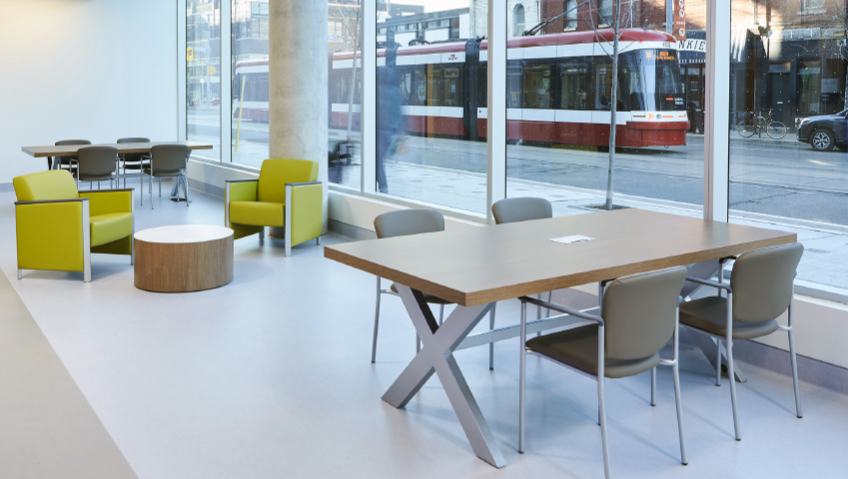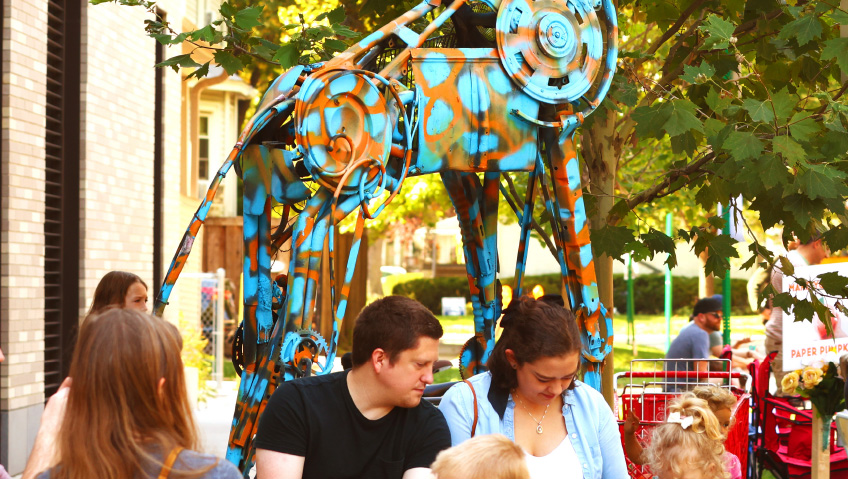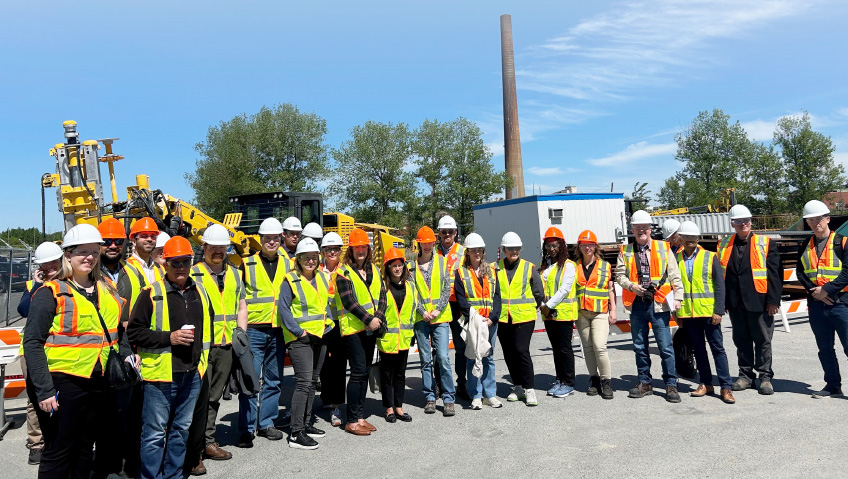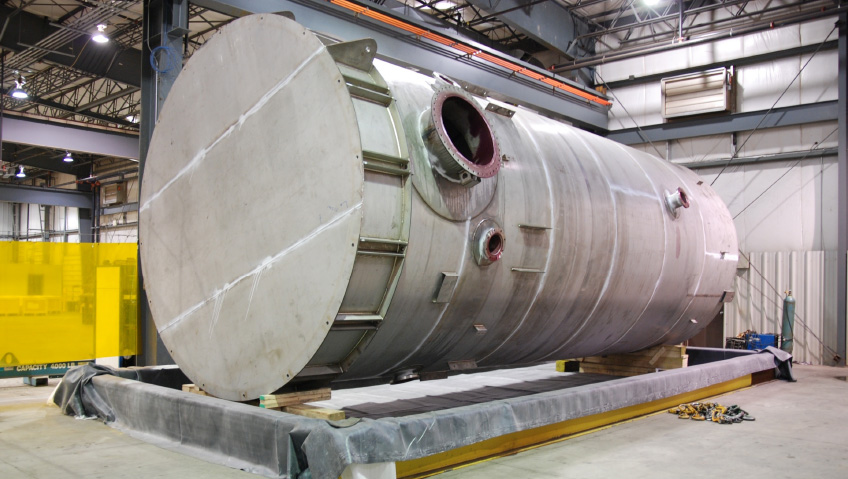Who says furniture can’t be strong and functional while also embracing stylish construction? Spec Furniture, a completely integrated company with a manufacturing process that utilizes North American sourced products and materials, shows that it can.
Focusing on four contract market sectors—education, corporate, government, and a specialty in healthcare—Spec brings a distinctive customer-oriented approach with designs that allow customers to choose from a wide range of options and price ranges to fit a variety of specialized needs.
With installations found across North America, Spec is backed by an industry-leading guarantee and a commitment to first-rate customer service.
“What we do well for the customer is give them as many options as possible and then align on that in our build-to-order strategy,” says Stefan Robertson, Director of Operations. “We don’t have a lot of stock of completed product; we have components that we’ve purchased or parts that will arrive once we have an order with the customer.”
This strategy allows numerous choices in the customization of table height, finishes, frames, types of fabric, and colors. With a metal shop, wood shop and paint line in-house, the company also does all its own finishings, controlling the process from start to end.
“If we have an order for 100 chairs in silver, and they want another 100 chairs in bright blue, that doesn’t come from two separate factories or get sent somewhere else for paint. We’re able to do that here,” says Robertson, “and the same with upholstery. We sew all our own covers here, so we’re able to take what the customer wants and configure that to the order.”
Not only is it part of Spec’s values to source from North American companies, but also support local businesses and groups in the area, which provides the company with manufacturing benefits as well.
“We’re not waiting on container loads to get dropped off from a ship being held up for any number of months,” says Chris Benjamin, Director, Product Development and Engineering. “That speaks to our flexibility and helps support businesses like ours in the industry.”
This also has some very practical benefits in terms of doing smaller pack sizes, which lends itself to customization and the ability to help customers find what they’re looking for.
“It also gives us more flexibility in the manufacturing process as far as lead time of parts, the ability to do smaller-volume customs, and the ability to turn orders around quickly,” says Benjamin.
All of which came in handy during the past two years and the supply chain upheaval due to the pandemic.
“Looking at the impact on business as far as lead times go, we’re certainly able to keep that under control,” says Robertson. “When other companies were experiencing offshore disruptions importing in containers from places outside the country, we didn’t feel that, and we still don’t.”
Being able to be build-to-order using locally sourced North American-made parts creates a more controlled supply chain, Robertson adds. While Spec does have some subcontracted products like screws and glides, the vast majority are produced in North America.
When it comes to Spec’s range of products, its niche area is rooted in the behavioural health sector, arising from an opportunity in an undefined sector 15 years ago when the customer didn’t necessarily know what it wanted, and Spec didn’t necessarily know what to provide.
“It was very much order-by-order and opportunity-by-opportunity treated as custom situations,” says Robertson. “We would take standard product and modify it to the customer expectation.”
Each facility and expectation was very different depending on whether it was U.S. or Canadian, the type of hospital or care center, and the kind of care being provided to the end-user. As the years have progressed, however, both the markets and the opportunities have become more defined and consolidated into behavioural health.
“It’s still being defined, but there’s more of an understanding that there are differences for each offering and each kind of end-user,” says Robertson. “Spec is very much committed to and partnered with those different opportunities.”
Spec’s Hardi line of chairs, for instance, is made from rotationally molded polyethylene, is easy to clean, and is virtually indestructible.
“It’s very much devoted toward a certain outcome,” he adds. “That’s something. If you look back 15 years ago, we had nothing even close to that.” This development still allows some customization of color and weight and evolved from the need to satisfy a specific end-user experience.
“That’s why we’ve had such success in that niche because we can customize our product so easily,” says Kelly Keess, Director, Sales and Marketing. “We manufacture in Canada, and pretty much all of our core components come from North America, and that allows us to be much more flexible and offer more variations.”
This also means no bulk pieces coming from overseas in huge shipments; instead, Spec can customize and order just a few pieces at a time.
“In behavioural health what we’ve learned is every hospital is different, and within these, every area of the hospital is different depending on their level of supervision, and the propensity for violence or self-harm,” says Keess. “All these things are taken into consideration and because of that, you can’t just offer a product off the shelf that would meet all needs.”
Switching parts of products out to make them safe in specific spaces is vital. This includes creating custom fully-enclosed upholstery for facilities concerned about concealment, or offering specialized chair glides to accommodate different types of flooring. “Being able to do all these little tweaks and variations has made us successful in that market niche.”
Making these adjustments involves group work within the company, combined with feedback across the behavioural health spectrums. Researching new standards provides insight and ideas, but for every opportunity Spec has received that way, another comes from collaborative work with end-users and dealers for specific facility requirements.
“We’ve responded very directly to people’s custom requests and have said we would be happy to try out what they were looking for as a sample, then send it to them for feedback based on what we think would work well, saying, ‘if you’re looking to do something like this, well, here’s what we think we can do,’” says Benjamin.
Samples, tests, and feedback from end-users and different medical teams have led to products that have become standard, and it’s led to excellent learnings in the health space, he adds, all of which help the behavioural health sector receive much-needed focus.
“There’s lots of other research going into this market as well, forcing it to continue to change, so it’s exciting,” says Keess. “We know the physical environment has a big effect on the healing process, and the space around you can affect how calm or how safe you feel. Those are big factors in healing.”
Along with caring for the health sector, the company is committed to environmental care as well, continuously minimizing negative environmental effects by putting in place an environmental management system that complies with ISO 14001. Spec also has its BIFMA (Business and Institutional Furniture Manufacturer’s Association) Level certification, which sponsors the development and maintenance of furniture safety, performance, and sustainability standards that impact people’s lives.
“We are a long-time partner,” says Benjamin. “BIFMA’s been a part of the Spec process from the start. It’s provided a framework for a lot of the values we have and the things we want to do and see, and it’s provided it in a coordinated way that prioritizes some of those things.”
Most of the work done early on focused on who Spec was as a manufacturer, its processes, and materials used, and helped make it more sustainable and environmentally friendly.
“Today we’re looking at the broader picture of sustainability,” Benjamin says. “As we come into our recertification of the 2019 standard, we’ll be taking a good look at a more holistic picture of sustainability and how our company goes after it. How can we further benefit from this and in doing so benefit our customers, our employees, and our communities as well.”
This means not only using more sustainable materials, watching for standards such as low VOC stains, and using high-content recycled materials for seats and plastic components, but also looking deeper into community engagement, sustainable supply chain partnerships, and the holistic development of employees.
Sustainability doesn’t fly in the face of good business or doing well as a company, he adds, and it’s beneficial to the business and community over the long run. This also means designing products in a more meaningful and sustainable way.
“As we look to this year and the years coming, we’re saying, ‘what are we doing and how does it line up with BIFMA, line up with customer expectations, line up with our lead time, and what we are trying to do with the organization as a whole?’” says Robertson. “Waste elimination is good business; they’re not separate from each other.”
As for other challenges, COVID did affect the company, but also generated some achievements, says Keess.
“We set ourselves up for success, facing that challenge, because we prioritized the North American supply chain. It gave us a bit more variability. We have great relationships with the suppliers because they’re local and we’re local. Helping support local manufacturing and building community unity did help us face that challenge.”
Going forward, it’s more about thriving than surviving, Robertson adds.
“How are we going to move forward and bring our partners and customers along with us,” he asks. “It’s that mindset change a little bit, but at the same time, it’s just doing it in a way, that if you do it right, will separate us from our competitors even more.”
This includes connecting digitally with customers in more meaningful ways.
“We’ve moved forward in a lot of ways, but there’s still room for improvement and the customers are changing their expectations as to how they want to interact with us even more so.”
From an operational standpoint, Spec continues to look at reducing lead times, driving its material selection toward recycled and renewable content, and considering automation of both the order-entry process and the manufacturing processes.
Focusing on how to make things easier for the customer is key, but that doesn’t mean replacing employees with robots, says Benjamin. “We want automation and technology to make our customers’ experiences better, but we believe we can do that in a way which benefits our employees and partners, making their experience better as well.”
Spec will also continue to put its customers first, emphasizing its approach of listening to the customer and focusing on what they want, rather than telling them what they need.
“We’re open-minded with what our customers are looking for,” says Keess. “We don’t shy away from an unusual custom product, because we learn a lot about the way that company is working, or that healthcare facility is operating. We learn a lot about what challenges our customers are facing just by listening to them.”
Understanding the market needs and design changes customers are looking for also allows Spec to meet those needs much more openly and easily.
“Our openness to that feedback from our customers on our products does set us apart,” Keess adds. “It helps us become a solution provider and then it also helps us learn while we’re doing it. It makes it fun.”






